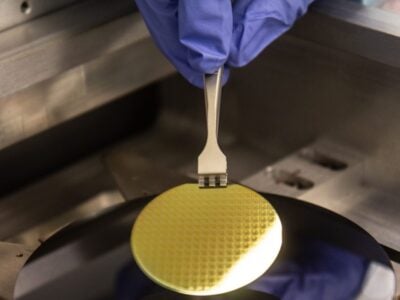
Rambus takes aim at ARM in IoT security
“Rambus has had a very interesting history, billions of dollars flowed in through high value licensing with the first versions of the company, you might call them Rambus 1.0 and 2.0,” said Jerome Nadel, senior vice president and CMO of Rambus. “The thing that held these technologies together was a licensing platform, from LED lighting to differential power analysis.”
It started out with high speed serial interface designs that were patented and the patents and technology licensed to a wide range of customers. Other technologies were then added to the licensing platform, creating a disparate set to IP. Acquisitions for Memory and Interface division and Rambus Security included the memory interconnect technology from Inphi that has been used to develop a family of buffer chips, as well as the Snowbush serial/deserialization IP from Semtec. Using those skills, Rambus has since developed interfaces for the latest GDDR6 graphics chips.
But there is also fundamental research into next generation systems and reducing the power consumption in data centres.
“We continue to develop emerging solutions. We work with companies like IBM and Microsoft on research programmes that they pay us for where we create IP that we can license, such as hybrid memory,” he said. “That’s an area where we model and characterise and build prototypes that become the next generation standards.”
Cloud computing requires large data centres and the advent of artificial intelligence and machine learning means the role of buffers and faster interfaces becomes more and more important.
“As a data company we want to move data fast and keep data safe,” said Nadel. “For example, there’s ‘cold computing’ with Microsoft. We have a multiyear project on how systems work at 77K, and we have moved to building boards and products on this.”
Next: Crypto
“There’s so much data going through and heat being generated, Microsoft sees cold as the future. There’s going to be so much data movement we need to look at new models, so there’s a lot of applications for cold computing.”
Then there was the acquisition of Cryptography research in 2011 for $342m as part of that disparate IP platform, bringing fundamental patents on differential power analysis (DPA) that would protect chips from being monitored.
“On top of Cryptography Research acquisition, there was an expectation that DPA would be used in mobile phone handsets but that didn’t happen. Every EMV chipcard has this technology but the royalty rates are super low. The ability to license was definitely constrained but we thought if we could put a secure core as a hardware root of trust in an SoC and have key software to manage that we could have better lifecycle management. Instead of firmware updated over the air (OTA) we could be going back to a hardware route of trust for anti-counterfeiting and content protection. Qualcomm has billions of WiFi and radio chips with our cores in them, managed by a software platform called Cryptomanager.”
“The vision hasn’t fully materialised, but with features as a service, you start at the fab and then in the field update it securely with new services,” he said. This opens up a service model, where customers or Rambus can manage the updating of the chips in the field.
The company has developed a secure core that can sit alongside a mainstream processor to provide this capability, starting with the RISC-V core. “We silo the secure processing from general processing and partnering with SiFive and promoting open source hardware, this notion of cores that can be programmed and addressed in field is a very relevant model – design starts are so expensive you could democratise those and make money in the field,” he said.
“On the platform level you have to be open to other cores so we [interface to processor cores from] TI, ST, Synopsys, our infrastructure interfaces with our cores and other cores – we have interfaces for a set of cores with a software development kit (SDK) and product development kit (PDK).
Next: Competing with ARM
Does this mean Rambus is competing with ARM’s Trustzone hardware? He points to the fact that a Cybertrust Japan, a division of Softbank, ARM’s owner, picked the Rambus Cryptomanager for IoT device provisioning.
“Trustzone you could look at as a competitor but what we are doing is more architecturally secure. If they need DPA the only way to get that is from us, just saying,” he said.
This led the company into the application space through the acquisition of the assets of Smart Card Software for £64.7m in 2016. This included Ecebs in East Kilbride and Bell Identification (Bell ID) in Rotterdam.
Bell ID pioneered host card emulation and tokenisation that is used as the NFC infrastructure under Apple Pay and Android Pay. A token cryptographically hides the details of the data being sent to open up secure transactions.
“Now we can secure the transaction, whether that’s cryptocurrencies, gift cards, loyalty points as well as cash, and we go all the way up to the user interface (UI), so you can pay in anyway you want as the payment details have been tokenised.”
It is this software layer on top of the secure core that will allow more growth. “We think that at a software level we can get to more markets faster and grow through the software uses of tokenisation,” he said.
Next: Growth
All of this is driving the growth of Rambus.
“We look at the turnaround in the growth of the company – I think strategically we have already transformed the company, the seeds have been sown and now we are seeing the growth. But we are not getting credit on the security side.”
A semiconductor company is valued differently from a security company or a software platform IoT company – so where is Rambus going now with its aim to move data quickly and safely?
“We think we have built a viable business with viable licensing revenue, but we have to deploy the security technology more aggressively,” said Nadel. “We hover just below $500m in revenue – once we pass that mark then we have more clout.”
Related stories:
- RAMBUS, GIGADEVICE FORM RERAM JOINT VENTURE
- DO SUPERCONDUCTING PROCESSORS REALLY NEED CRYOGENIC MEMORIES? THE CASE FOR COLD DRAM
- RAMBUS REPORTEDLY EXPLORING SALE OPTION
 If you enjoyed this article, you will like the following ones: don't miss them by subscribing to :
eeNews on Google News
If you enjoyed this article, you will like the following ones: don't miss them by subscribing to :
eeNews on Google News




